Презентация customer markets


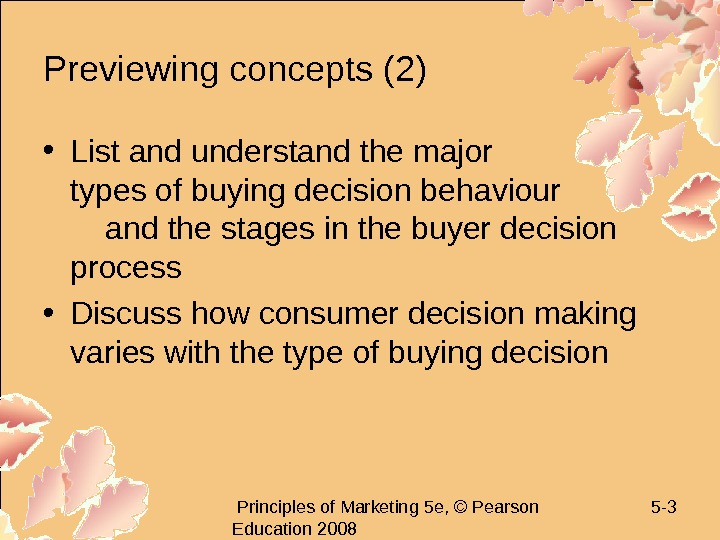
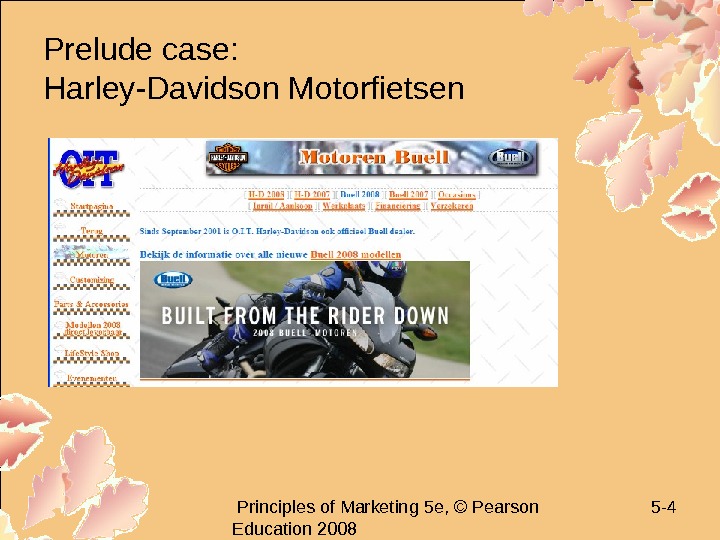
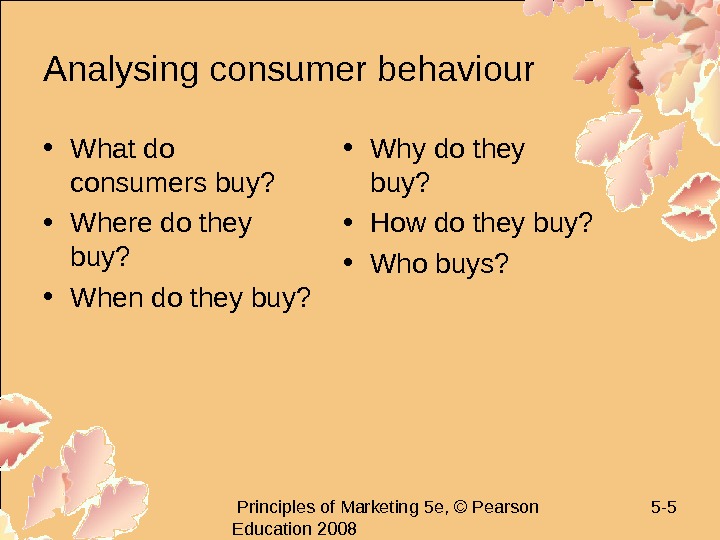

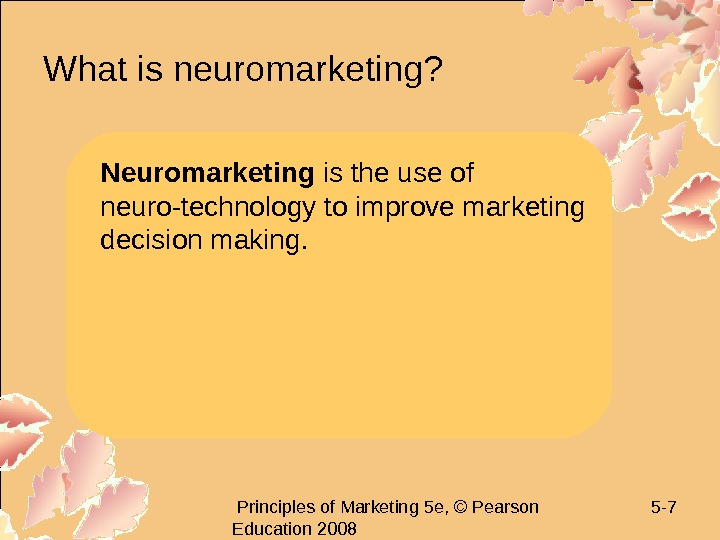

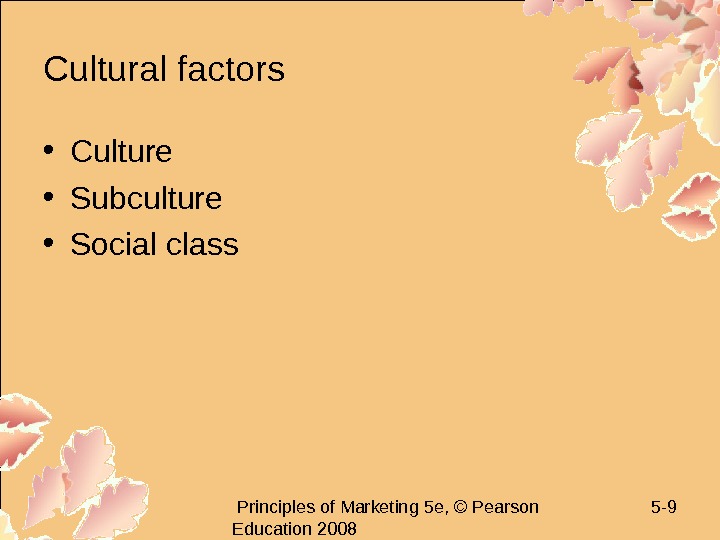

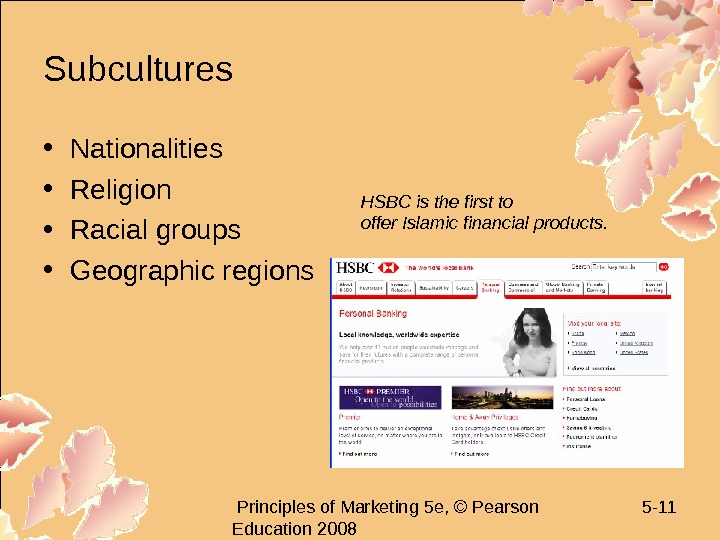
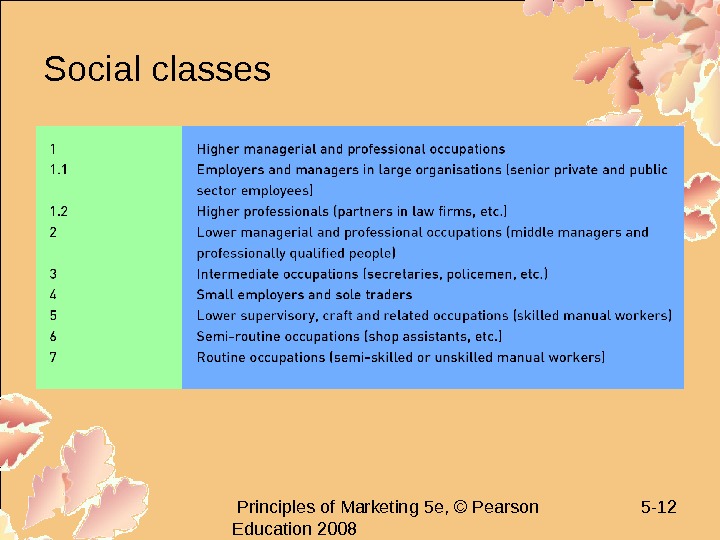
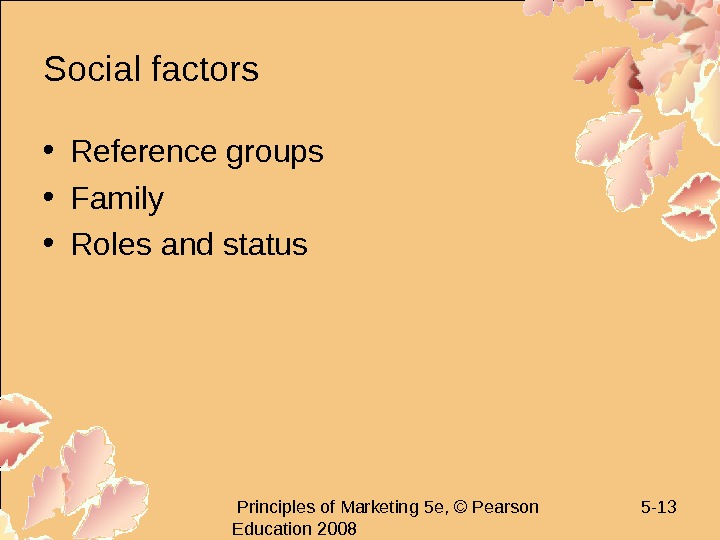
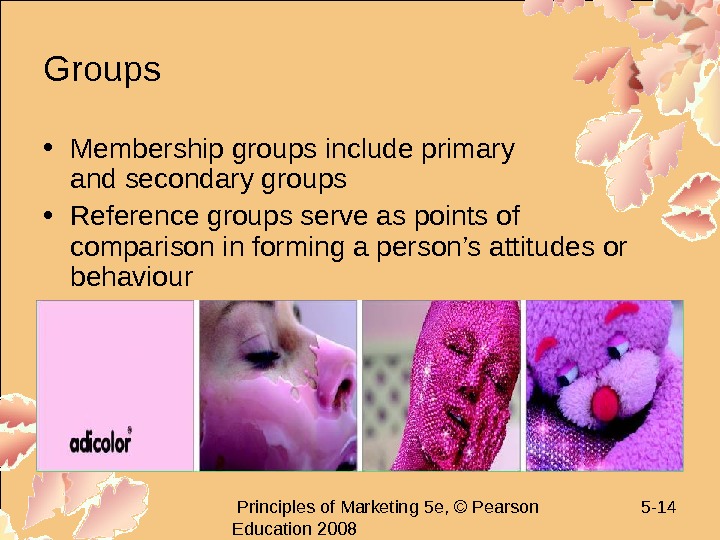






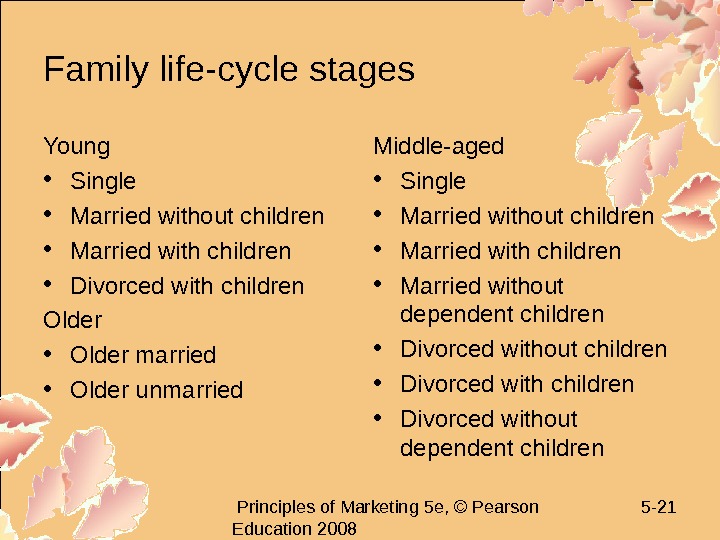


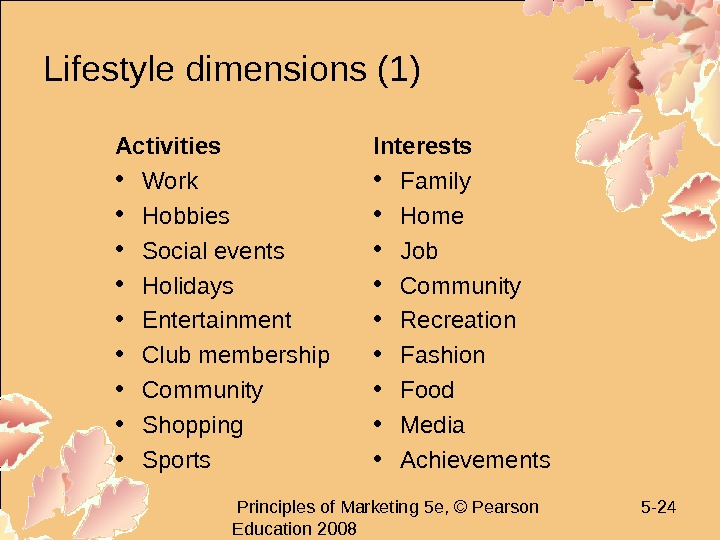





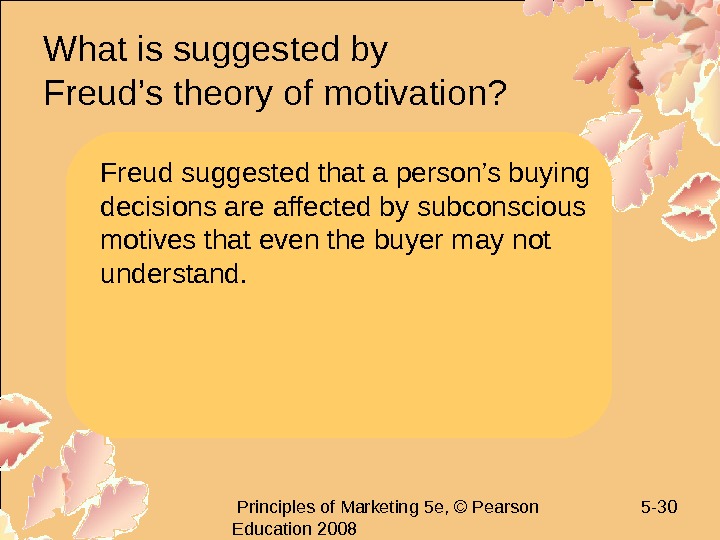

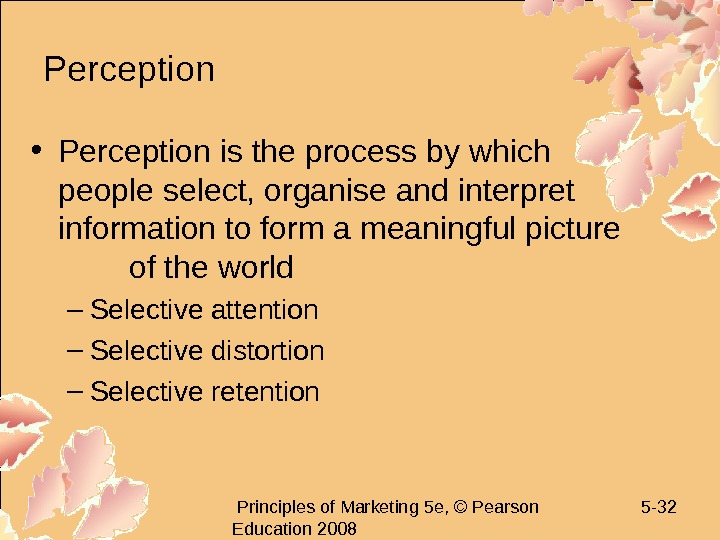
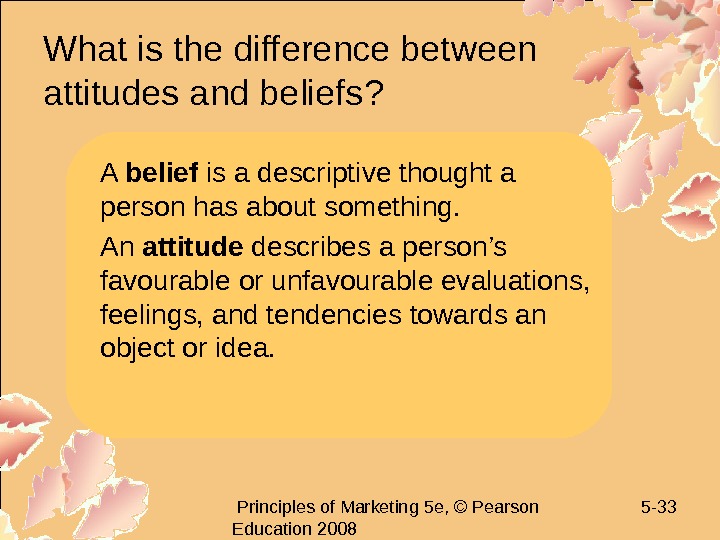


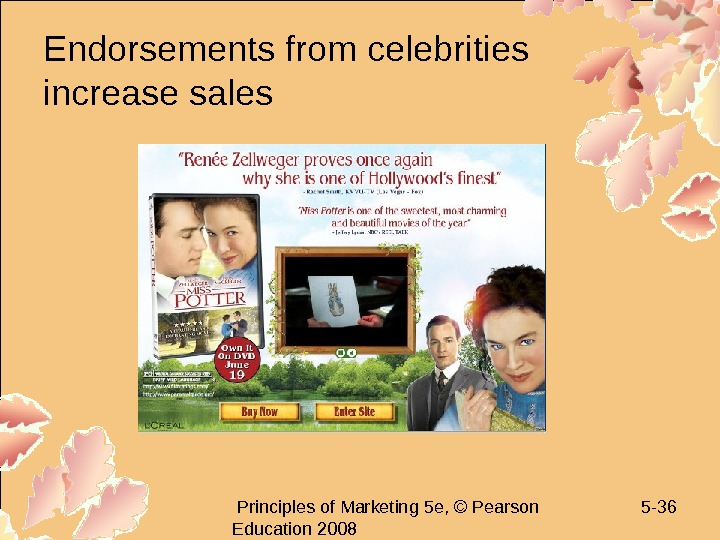

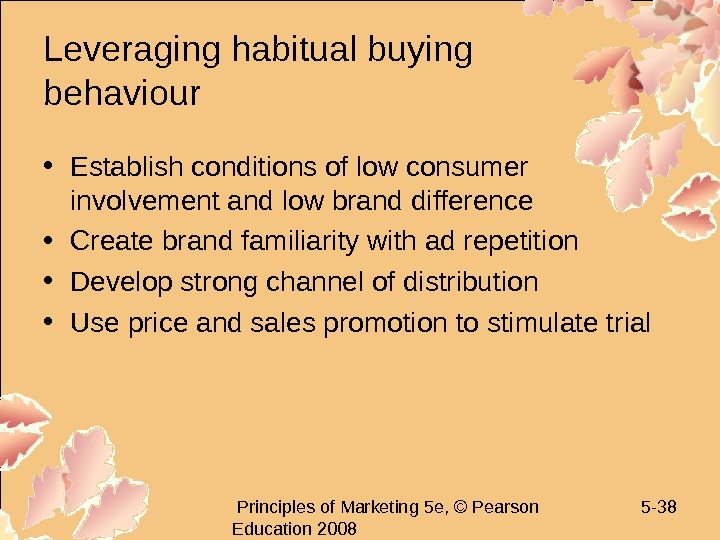


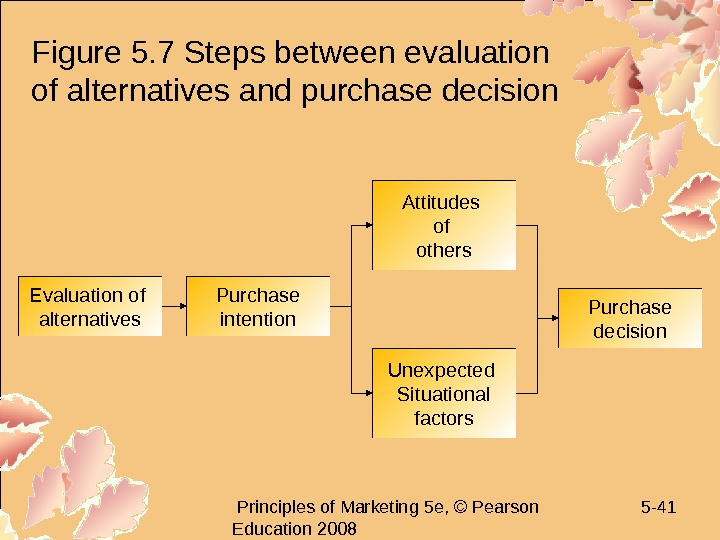



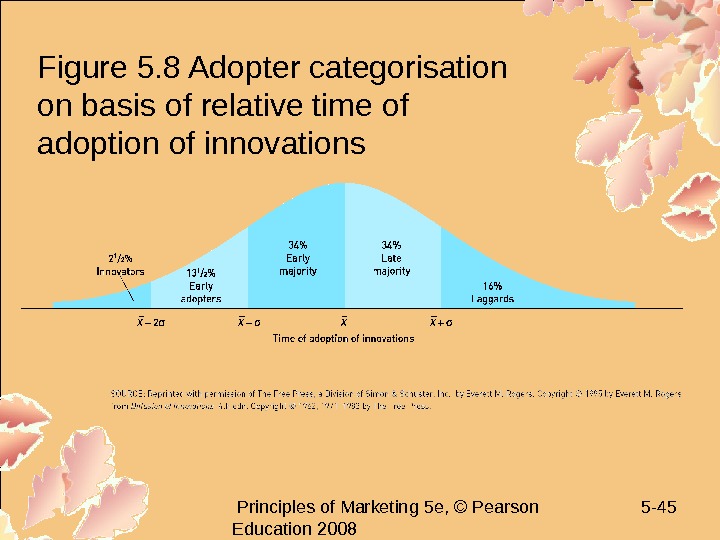


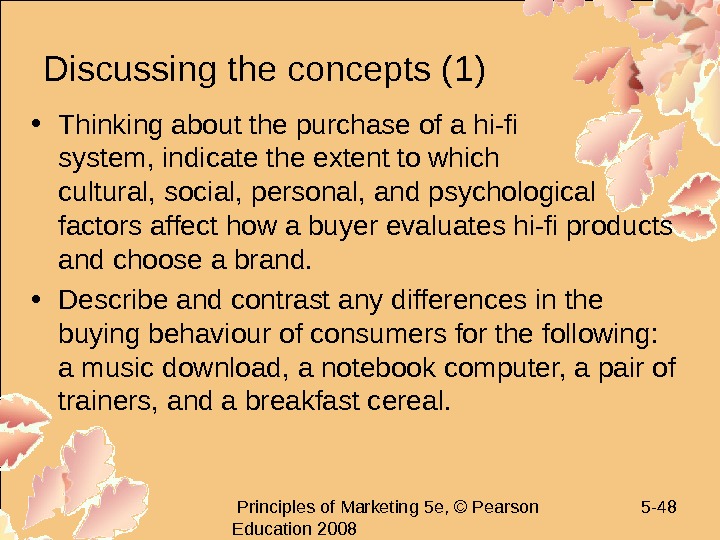

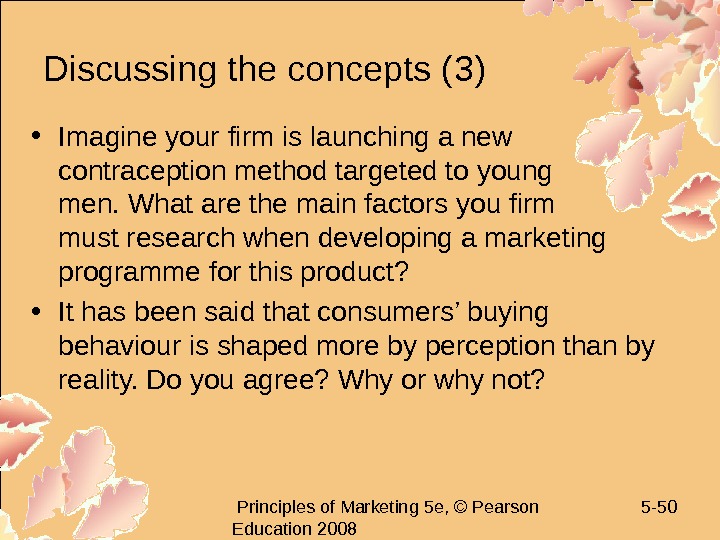
- Размер: 4.8 Mегабайта
- Количество слайдов: 50
Описание презентации Презентация customer markets по слайдам
 Principles of Marketing FIFTH EUROPEAN EDITION Kotler, Armstrong, Wong, Saunders. Consumer marketsf i v e. CHAPTER
Principles of Marketing FIFTH EUROPEAN EDITION Kotler, Armstrong, Wong, Saunders. Consumer marketsf i v e. CHAPTER
 Principles of Marketing 5 e, © Pearson Education 2008 5 — 2 Previewing concepts (1) • Define the consumer market and construct a simple model of consumer buyer behaviour • Tell how culture, subculture and social class influence consumer buying behaviour • Describe how consumers’ personal characteristics and primary psychological factors affect their buying decisions
Principles of Marketing 5 e, © Pearson Education 2008 5 — 2 Previewing concepts (1) • Define the consumer market and construct a simple model of consumer buyer behaviour • Tell how culture, subculture and social class influence consumer buying behaviour • Describe how consumers’ personal characteristics and primary psychological factors affect their buying decisions
 Principles of Marketing 5 e, © Pearson Education 2008 5 — 3 Previewing concepts (2) • List and understand the major types of buying decision behaviour and the stages in the buyer decision process • Discuss how consumer decision making varies with the type of buying decision
Principles of Marketing 5 e, © Pearson Education 2008 5 — 3 Previewing concepts (2) • List and understand the major types of buying decision behaviour and the stages in the buyer decision process • Discuss how consumer decision making varies with the type of buying decision
 Principles of Marketing 5 e, © Pearson Education 2008 5 — 4 Prelude case: Harley-Davidson Motorfietsen
Principles of Marketing 5 e, © Pearson Education 2008 5 — 4 Prelude case: Harley-Davidson Motorfietsen
 Principles of Marketing 5 e, © Pearson Education 2008 5 — 5 Analysing consumer behaviour • What do consumers buy? • Where do they buy? • When do they buy? • Why do they buy? • How do they buy? • Who buys?
Principles of Marketing 5 e, © Pearson Education 2008 5 — 5 Analysing consumer behaviour • What do consumers buy? • Where do they buy? • When do they buy? • Why do they buy? • How do they buy? • Who buys?
 Principles of Marketing 5 e, © Pearson Education 2008 5 — 6 Figure 5. 1 Stimulus-response model of buyer behaviour Marketing and stimuli Buyer’s black box Buyer responses
Principles of Marketing 5 e, © Pearson Education 2008 5 — 6 Figure 5. 1 Stimulus-response model of buyer behaviour Marketing and stimuli Buyer’s black box Buyer responses
 Principles of Marketing 5 e, © Pearson Education 2008 5 — 7 What is neuromarketing? Neuromarketing is the use of neuro-technology to improve marketing decision making.
Principles of Marketing 5 e, © Pearson Education 2008 5 — 7 What is neuromarketing? Neuromarketing is the use of neuro-technology to improve marketing decision making.
 Principles of Marketing 5 e, © Pearson Education 2008 5 — 8 Figure 5. 2 Factors influencing consumer behaviour Cultural Social Personal Psycho- logical Buyer
Principles of Marketing 5 e, © Pearson Education 2008 5 — 8 Figure 5. 2 Factors influencing consumer behaviour Cultural Social Personal Psycho- logical Buyer
 Principles of Marketing 5 e, © Pearson Education 2008 5 — 9 Cultural factors • Culture • Subculture • Social class
Principles of Marketing 5 e, © Pearson Education 2008 5 — 9 Cultural factors • Culture • Subculture • Social class
 Principles of Marketing 5 e, © Pearson Education 2008 5 — 10 What is culture? Culture is the set of basic values, perceptions, wants and behaviours learned by a member of society from family and other important institutions.
Principles of Marketing 5 e, © Pearson Education 2008 5 — 10 What is culture? Culture is the set of basic values, perceptions, wants and behaviours learned by a member of society from family and other important institutions.
 Principles of Marketing 5 e, © Pearson Education 2008 5 — 11 Subcultures • Nationalities • Religion • Racial groups • Geographic regions HSBC is the first to offer Islamic financial products.
Principles of Marketing 5 e, © Pearson Education 2008 5 — 11 Subcultures • Nationalities • Religion • Racial groups • Geographic regions HSBC is the first to offer Islamic financial products.
 Principles of Marketing 5 e, © Pearson Education 2008 5 — 12 Social classes
Principles of Marketing 5 e, © Pearson Education 2008 5 — 12 Social classes
 Principles of Marketing 5 e, © Pearson Education 2008 5 — 13 Social factors • Reference groups • Family • Roles and status
Principles of Marketing 5 e, © Pearson Education 2008 5 — 13 Social factors • Reference groups • Family • Roles and status
 Principles of Marketing 5 e, © Pearson Education 2008 5 — 14 Groups • Membership groups include primary and secondary groups • Reference groups serve as points of comparison in forming a person’s attitudes or behaviour
Principles of Marketing 5 e, © Pearson Education 2008 5 — 14 Groups • Membership groups include primary and secondary groups • Reference groups serve as points of comparison in forming a person’s attitudes or behaviour
 Principles of Marketing 5 e, © Pearson Education 2008 5 — 15 What is an opinion leader? Opinion leaders are people within a reference group who, because of special skills, knowledge, personality, or other characteristics, exert influence on others.
Principles of Marketing 5 e, © Pearson Education 2008 5 — 15 What is an opinion leader? Opinion leaders are people within a reference group who, because of special skills, knowledge, personality, or other characteristics, exert influence on others.
 Principles of Marketing 5 e, © Pearson Education 2008 5 — 16 Figure 5. 3 Extent of group influence on product and brand choice
Principles of Marketing 5 e, © Pearson Education 2008 5 — 16 Figure 5. 3 Extent of group influence on product and brand choice
 Principles of Marketing 5 e, © Pearson Education 2008 5 — 17 VW’s Helga relied on social networking for branding
Principles of Marketing 5 e, © Pearson Education 2008 5 — 17 VW’s Helga relied on social networking for branding
 Principles of Marketing 5 e, © Pearson Education 2008 5 — 18 Family influences Family of orientation Family of procreation
Principles of Marketing 5 e, © Pearson Education 2008 5 — 18 Family influences Family of orientation Family of procreation
 Principles of Marketing 5 e, © Pearson Education 2008 5 — 19 Consumers’ buying roles • Initiator • Influencer • Decider • Buyer • User
Principles of Marketing 5 e, © Pearson Education 2008 5 — 19 Consumers’ buying roles • Initiator • Influencer • Decider • Buyer • User
 Principles of Marketing 5 e, © Pearson Education 2008 5 — 20 Personal factors • Buyer’s age • Lifecycle stage • Occupation • Economic situation • Lifestyle • Personality • Self-concept
Principles of Marketing 5 e, © Pearson Education 2008 5 — 20 Personal factors • Buyer’s age • Lifecycle stage • Occupation • Economic situation • Lifestyle • Personality • Self-concept
 Principles of Marketing 5 e, © Pearson Education 2008 5 — 21 Family life-cycle stages Young • Single • Married without children • Married with children • Divorced with children Older • Older married • Older unmarried Middle-aged • Single • Married without children • Married without dependent children • Divorced without dependent children
Principles of Marketing 5 e, © Pearson Education 2008 5 — 21 Family life-cycle stages Young • Single • Married without children • Married with children • Divorced with children Older • Older married • Older unmarried Middle-aged • Single • Married without children • Married without dependent children • Divorced without dependent children
 Principles of Marketing 5 e, © Pearson Education 2008 5 — 22 Lifestyle segmentation Activities Interests Opinions Demographics
Principles of Marketing 5 e, © Pearson Education 2008 5 — 22 Lifestyle segmentation Activities Interests Opinions Demographics
 Principles of Marketing 5 e, © Pearson Education 2008 5 — 23 Lifestyle segmentation Marketing Birmingham
Principles of Marketing 5 e, © Pearson Education 2008 5 — 23 Lifestyle segmentation Marketing Birmingham
 Principles of Marketing 5 e, © Pearson Education 2008 5 — 24 Lifestyle dimensions (1) Activities • Work • Hobbies • Social events • Holidays • Entertainment • Club membership • Community • Shopping • Sports Interests • Family • Home • Job • Community • Recreation • Fashion • Food • Media • Achievements
Principles of Marketing 5 e, © Pearson Education 2008 5 — 24 Lifestyle dimensions (1) Activities • Work • Hobbies • Social events • Holidays • Entertainment • Club membership • Community • Shopping • Sports Interests • Family • Home • Job • Community • Recreation • Fashion • Food • Media • Achievements
 Principles of Marketing 5 e, © Pearson Education 2008 5 — 25 Lifestyle dimensions (2) Opinions • Themselves • Social issues • Politics • Business • Economics • Education • Products • Future • Culture Demographics • Age • Education • Income • Occupation • Family size • Dwelling • Geography • City or town size • Stage in life cycle
Principles of Marketing 5 e, © Pearson Education 2008 5 — 25 Lifestyle dimensions (2) Opinions • Themselves • Social issues • Politics • Business • Economics • Education • Products • Future • Culture Demographics • Age • Education • Income • Occupation • Family size • Dwelling • Geography • City or town size • Stage in life cycle
 Principles of Marketing 5 e, © Pearson Education 2008 5 — 26 Lifestyle
Principles of Marketing 5 e, © Pearson Education 2008 5 — 26 Lifestyle
 Principles of Marketing 5 e, © Pearson Education 2008 5 — 27 What is personality? Personality is a person’s distinguishing psychological characteristics that lead to relatively consistent and lasting responses to his or her own environment.
Principles of Marketing 5 e, © Pearson Education 2008 5 — 27 What is personality? Personality is a person’s distinguishing psychological characteristics that lead to relatively consistent and lasting responses to his or her own environment.
 Principles of Marketing 5 e, © Pearson Education 2008 5 — 28 Brand personalities Sincerity Excitement Competence. Sophistication Ruggedness
Principles of Marketing 5 e, © Pearson Education 2008 5 — 28 Brand personalities Sincerity Excitement Competence. Sophistication Ruggedness
 Principles of Marketing 5 e, © Pearson Education 2008 5 — 29 Psychological factors • Motivation • Perception • Learning • Beliefs and attitudes
Principles of Marketing 5 e, © Pearson Education 2008 5 — 29 Psychological factors • Motivation • Perception • Learning • Beliefs and attitudes
 Principles of Marketing 5 e, © Pearson Education 2008 5 — 30 What is suggested by Freud’s theory of motivation? Freud suggested that a person’s buying decisions are affected by subconscious motives that even the buyer may not understand.
Principles of Marketing 5 e, © Pearson Education 2008 5 — 30 What is suggested by Freud’s theory of motivation? Freud suggested that a person’s buying decisions are affected by subconscious motives that even the buyer may not understand.
 Principles of Marketing 5 e, © Pearson Education 2008 5 — 31 Figure 5. 4 Maslow’s hierarchy of needs
Principles of Marketing 5 e, © Pearson Education 2008 5 — 31 Figure 5. 4 Maslow’s hierarchy of needs
 Principles of Marketing 5 e, © Pearson Education 2008 5 — 32 Perception • Perception is the process by which people select, organise and interpret information to form a meaningful picture of the world – Selective attention – Selective distortion – Selective retention
Principles of Marketing 5 e, © Pearson Education 2008 5 — 32 Perception • Perception is the process by which people select, organise and interpret information to form a meaningful picture of the world – Selective attention – Selective distortion – Selective retention
 Principles of Marketing 5 e, © Pearson Education 2008 5 — 33 What is the difference between attitudes and beliefs? A belief is a descriptive thought a person has about something. An attitude describes a person’s favourable or unfavourable evaluations, feelings, and tendencies towards an object or idea.
Principles of Marketing 5 e, © Pearson Education 2008 5 — 33 What is the difference between attitudes and beliefs? A belief is a descriptive thought a person has about something. An attitude describes a person’s favourable or unfavourable evaluations, feelings, and tendencies towards an object or idea.
 Principles of Marketing 5 e, © Pearson Education 2008 5 — 34 Consumer decision process Consumer choice results from a complex interplay of cultural, social, personal, and psychological factors.
Principles of Marketing 5 e, © Pearson Education 2008 5 — 34 Consumer decision process Consumer choice results from a complex interplay of cultural, social, personal, and psychological factors.
 Principles of Marketing 5 e, © Pearson Education 2008 5 — 35 Figure 5. 5 Four types of buying behaviour
Principles of Marketing 5 e, © Pearson Education 2008 5 — 35 Figure 5. 5 Four types of buying behaviour
 Principles of Marketing 5 e, © Pearson Education 2008 5 — 36 Endorsements from celebrities increase sales
Principles of Marketing 5 e, © Pearson Education 2008 5 — 36 Endorsements from celebrities increase sales
 Principles of Marketing 5 e, © Pearson Education 2008 5 — 37 What is dissonance-reducing buying behaviour? Dissonance-reducing buying behaviour is consumer behaviour in situations characterised by high involvement but few perceived differences among brands.
Principles of Marketing 5 e, © Pearson Education 2008 5 — 37 What is dissonance-reducing buying behaviour? Dissonance-reducing buying behaviour is consumer behaviour in situations characterised by high involvement but few perceived differences among brands.
 Principles of Marketing 5 e, © Pearson Education 2008 5 — 38 Leveraging habitual buying behaviour • Establish conditions of low consumer involvement and low brand difference • Create brand familiarity with ad repetition • Develop strong channel of distribution • Use price and sales promotion to stimulate trial
Principles of Marketing 5 e, © Pearson Education 2008 5 — 38 Leveraging habitual buying behaviour • Establish conditions of low consumer involvement and low brand difference • Create brand familiarity with ad repetition • Develop strong channel of distribution • Use price and sales promotion to stimulate trial
 Principles of Marketing 5 e, © Pearson Education 2008 5 — 39 Leveraging variety-seeking buying behaviour • Establish situation of low consumer involvement and high perceived brand differences • Dominate shelf space • Avoid out-of-stock conditions • Run frequent reminder advertising • Offer lower prices, promotions, and free samples
Principles of Marketing 5 e, © Pearson Education 2008 5 — 39 Leveraging variety-seeking buying behaviour • Establish situation of low consumer involvement and high perceived brand differences • Dominate shelf space • Avoid out-of-stock conditions • Run frequent reminder advertising • Offer lower prices, promotions, and free samples
 Principles of Marketing 5 e, © Pearson Education 2008 5 — 40 Figure 5. 6 The buyer decision process Need recognition Information search Evaluation of alternatives Purchase decision Postpurchase behaviour
Principles of Marketing 5 e, © Pearson Education 2008 5 — 40 Figure 5. 6 The buyer decision process Need recognition Information search Evaluation of alternatives Purchase decision Postpurchase behaviour
 Principles of Marketing 5 e, © Pearson Education 2008 5 — 41 Figure 5. 7 Steps between evaluation of alternatives and purchase decision Evaluation of alternatives Purchase intention Attitudes of others Purchase decision Unexpected Situational factors
Principles of Marketing 5 e, © Pearson Education 2008 5 — 41 Figure 5. 7 Steps between evaluation of alternatives and purchase decision Evaluation of alternatives Purchase intention Attitudes of others Purchase decision Unexpected Situational factors
 Principles of Marketing 5 e, © Pearson Education 2008 5 — 42 Sources used during information search • Personal sources • Commercial sources • Public sources • Experiential sources
Principles of Marketing 5 e, © Pearson Education 2008 5 — 42 Sources used during information search • Personal sources • Commercial sources • Public sources • Experiential sources
 Principles of Marketing 5 e, © Pearson Education 2008 5 — 43 What do consumers do during the alternative evaluation stage of the buying process? • Look for certain benefits that can be acquired by buying a product • Attach degrees of importance to each attribute • Develop brand beliefs about each brand • Use a utility function for each attribute • Arrive at attitudes toward each brand through an evaluation procedure
Principles of Marketing 5 e, © Pearson Education 2008 5 — 43 What do consumers do during the alternative evaluation stage of the buying process? • Look for certain benefits that can be acquired by buying a product • Attach degrees of importance to each attribute • Develop brand beliefs about each brand • Use a utility function for each attribute • Arrive at attitudes toward each brand through an evaluation procedure
 Principles of Marketing 5 e, © Pearson Education 2008 5 — 44 Stages in adopting a new product • Awareness • Interest • Evaluation • Trial • Adoption
Principles of Marketing 5 e, © Pearson Education 2008 5 — 44 Stages in adopting a new product • Awareness • Interest • Evaluation • Trial • Adoption
 Principles of Marketing 5 e, © Pearson Education 2008 5 — 45 Figure 5. 8 Adopter categorisation on basis of relative time of adoption of innovations
Principles of Marketing 5 e, © Pearson Education 2008 5 — 45 Figure 5. 8 Adopter categorisation on basis of relative time of adoption of innovations
 Principles of Marketing 5 e, © Pearson Education 2008 5 — 46 Characteristics affecting rate of adoption Relative advantage Compatibility Complexity Divisibility Communicability
Principles of Marketing 5 e, © Pearson Education 2008 5 — 46 Characteristics affecting rate of adoption Relative advantage Compatibility Complexity Divisibility Communicability
 Principles of Marketing 5 e, © Pearson Education 2008 5 — 47 Using the rate of adoption characteristics, evaluate the likely rate of adoption for HDTV
Principles of Marketing 5 e, © Pearson Education 2008 5 — 47 Using the rate of adoption characteristics, evaluate the likely rate of adoption for HDTV
 Principles of Marketing 5 e, © Pearson Education 2008 5 — 48 Discussing the concepts (1) • Thinking about the purchase of a hi-fi system, indicate the extent to which cultural, social, personal, and psychological factors affect how a buyer evaluates hi-fi products and choose a brand. • Describe and contrast any differences in the buying behaviour of consumers for the following: a music download, a notebook computer, a pair of trainers, and a breakfast cereal.
Principles of Marketing 5 e, © Pearson Education 2008 5 — 48 Discussing the concepts (1) • Thinking about the purchase of a hi-fi system, indicate the extent to which cultural, social, personal, and psychological factors affect how a buyer evaluates hi-fi products and choose a brand. • Describe and contrast any differences in the buying behaviour of consumers for the following: a music download, a notebook computer, a pair of trainers, and a breakfast cereal.
 Principles of Marketing 5 e, © Pearson Education 2008 5 — 49 Discussing the concepts (2) • Why might a detailed understanding of the model of the consumer buying decision process help marketers develop more effective marketing strategies to capture and retain customers? How universal is the model? • In designing adverts for a soft drink, which would you find more helpful: information about demographics or lifestyles? Give examples.
Principles of Marketing 5 e, © Pearson Education 2008 5 — 49 Discussing the concepts (2) • Why might a detailed understanding of the model of the consumer buying decision process help marketers develop more effective marketing strategies to capture and retain customers? How universal is the model? • In designing adverts for a soft drink, which would you find more helpful: information about demographics or lifestyles? Give examples.
 Principles of Marketing 5 e, © Pearson Education 2008 5 — 50 Discussing the concepts (3) • Imagine your firm is launching a new contraception method targeted to young men. What are the main factors you firm must research when developing a marketing programme for this product? • It has been said that consumers’ buying behaviour is shaped more by perception than by reality. Do you agree? Why or why not?
Principles of Marketing 5 e, © Pearson Education 2008 5 — 50 Discussing the concepts (3) • Imagine your firm is launching a new contraception method targeted to young men. What are the main factors you firm must research when developing a marketing programme for this product? • It has been said that consumers’ buying behaviour is shaped more by perception than by reality. Do you agree? Why or why not?
